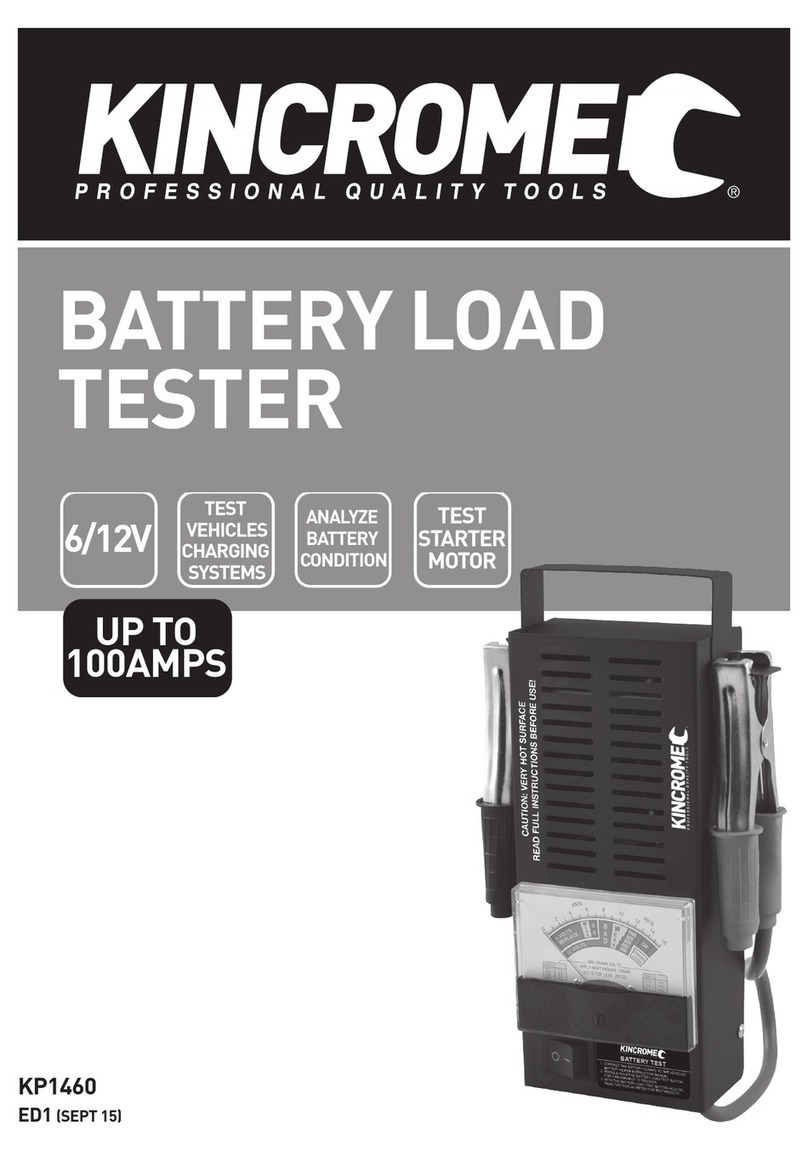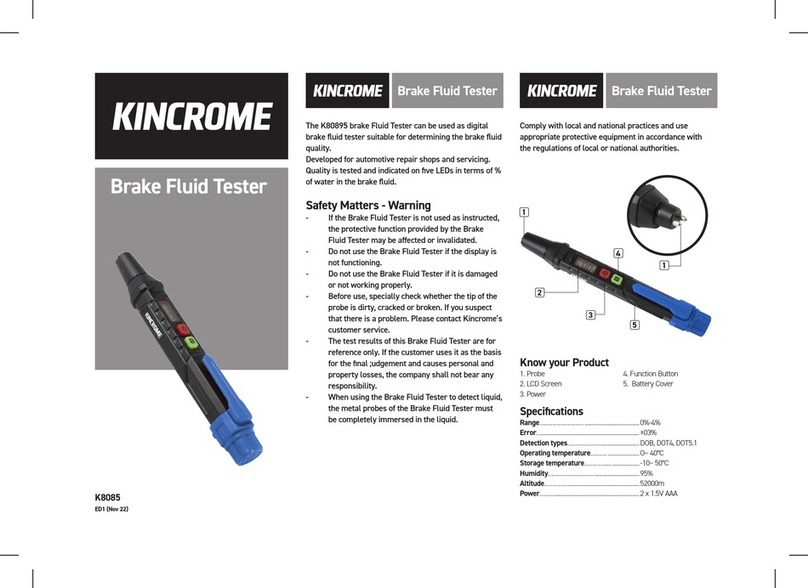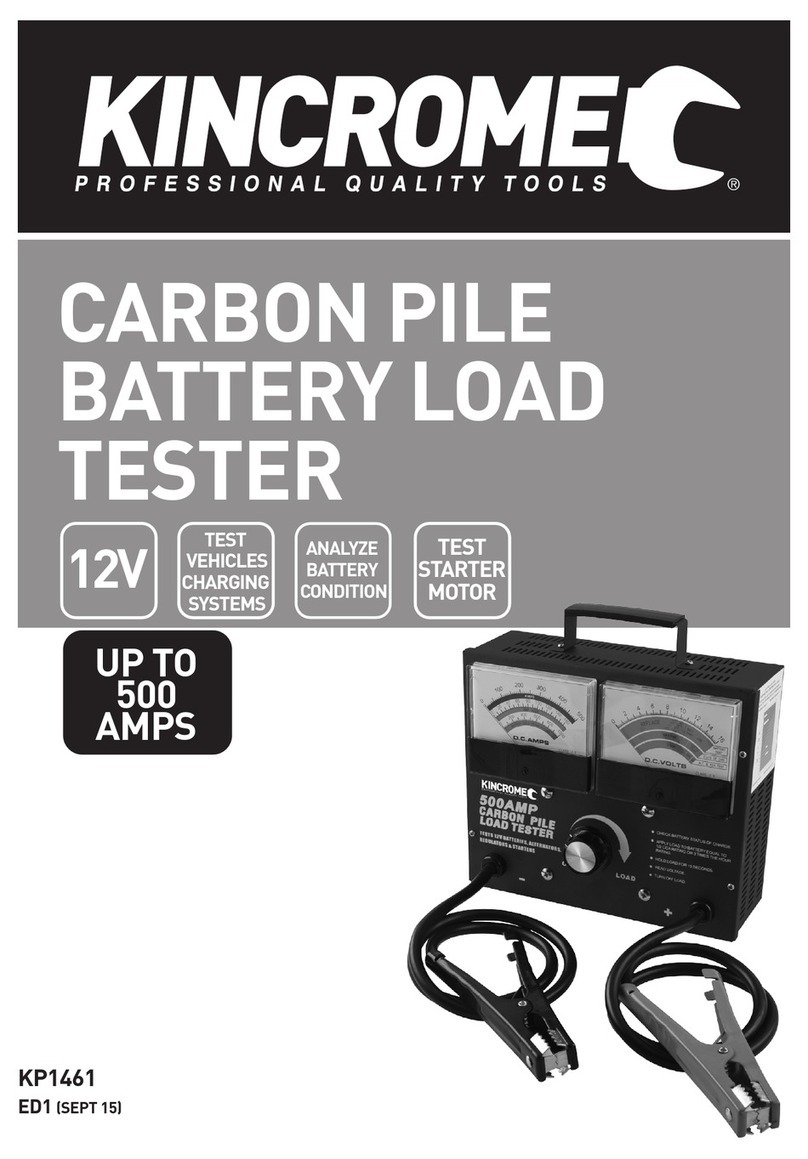6
8. Battery In-Vehicle or Battery Out-Of-Vehicle Tests
Battery in vehicle means the battery is connected to the vehicles
battery cables / terminals or vehicles accessories.
Out of Vehicle means the battery is not connected to the vehicles
battery cables / terminals.
A. Battery in Vehicle
1. Connect tester as specified “Connecting the Tester” (Page 3).
2. Press Enter Key (4) to navigate to Main Menu.
3. Press Up Key (1) / Down Key (2) to navigate to” 2. Battery in Vehicle” (Fig. 13)
and press Enter Key (4), it will enter “Test In Vehicle” menu (Fig. 14).
4. Choose one of the test as shown in Fig. 14 and press Enter Key (4).
B. Battery Test
The battery tester will test each battery according to the selected test standard
and rating.
1. Press Enter Key (4) on “1. Battery Test”, the “check surface charge” prompt
screen will display a sequence of instruction (Fig.15), which you are required
to follow before proceeding.
2. Once you have turned your headlights OFF, press the Enter Key (4).
C. Select Battery Type
1. The tester will prompt to select battery type (Fig. 16). Press Up Key (1) / Down
Key (2) to select battery type (as displayed on the battery rating label), then
press Enter Key (4) to confirm.
2. Press Up Key (1) / Down Key (2) to select the correct testing standard (Fig.17)
as specified on the battery rating label. Press Enter Key (4) to select testing
standard. Refer to the Battery System Standard Description page 13.
3. Press Up Key (1) / Down Key (2) to select the battery capacity rating
(Fig. 18) as displayed on the battery rating label. Press the Enter Key (4).
Note: A single Press Up Key (1) / Down Key (2) will increase / decrease by 5Amp
intervals, Press and hold Up Key (1) / Down Key (2) will increase /decrease
the rating rapidly.
4. The tester performs the test, It takes approximately 5-10 seconds to display
the battery test result.
5. Compare to the ‘Battery Test Result Examples’ on page 5.
6. Press the Exit Key (3) to return to the start-up screen.
D. Cranking Test
1. Connect tester as specified “Connecting the Tester” on Page 3.
2. Press Enter Key (4) to navigate to Main Menu.
3. Press Up Key (1) / Down Key (2) to select the battery location, ” 2. Battery in
Vehicle” then press Enter Key (4) to confirm (Fig14).
4. “Start Engine” is prompted (Fig.19), Start the vehicle and the tester will
perform the cranking test and display the result (Fig 20, 21 & 22) on Page 7.
5. Normally a cranking voltage value lower than 9.6V is regarded as abnormal,
click the Enter Key (4).
6. Test result includes cranking voltage and cranking time.
7. After testing finished Press the Exit Key (3) to return to the start-up screen.
Note: If this is the last test, turn off vehicle engine.
Main Menu
1. Quick Test
2. Battery in Vehicle
3. Out of Vehicle
4. Review Data
5. Print Data
6. System Setup
Test In Vehicle
1. Battery Test
2. Cranking Test
3. Charging Test
Battery Test
1. Check surface charge.
Turn lights ON
2. Turn headlights on for
approx. 10 seconds
3. Turn lights OFF
Battery Type
1. Regular Flooded
2. AGM Flat Plate
3. AGM Spiral
4. GEL
5. EFB
Select Input
CCA
Setting Rating
500
CCA
Fig. 13
Fig. 14
Fig. 15
Fig. 16
Fig. 17
Fig. 18
Cranking Test
Start Engine
Fig. 19






























